Multimedia Gallery
Apple Maggot (Rhagoletis pomonella)
The apple maggot (Rhagoletis pomonella) is a well-known example of incipient sympatric speciation. The divergence of this fly has led to parallel divergence in its parasitoid, the wasp Diachasma alloeum.
Research by ecologist Andrew Forbes of the University of California, Davis, found that when the apple maggot shifted hosts from the hawthorn tree to the apple, it triggered a cascading effect on the ecosystem.
Forbes and his colleagues found that the parasitic wasp D. alloeum, which attacks the apple maggot, has formed new incipient species as a result of specializing on diversifying fly hosts, including the apple-infesting race of R. pomonella.
The apple maggot, which is native to North America, shifted from its ancestral hawthorn host (Crataegus spp.) to the introduced European apple less than 250 years ago. "The two populations," Forbes said, "have since become partially reproductively isolated due to a number of host-related adaptations and are now distinct host races" (a group of organisms in the process of becoming a new species due to their close association with a particular host plant or animal). Forbes says this example of speciation in action may tell us more about why certain groups of organisms are more diverse than others, as well as suggest why certain areas and/or biotic regions may have more species than others.
[Research supported by a dissertation grant from the National Science Foundation (DEB 07-09647).] [This picture is associated with the following study: Forbes, A.A., L.L. Stelinski, T.H.Q. Powell, J.J. Smith and J.L. Feder. 2009. Sequential sympatric speciation across trophic levels. Science. 323: 776-779.] (Date of Image: 2006) [See related image Here.]
Credit: Andrew A. Forbes
Images and other media in the National Science Foundation Multimedia Gallery are available for use in print and electronic material by NSF employees, members of the media, university staff, teachers and the general public. All media in the gallery are intended for personal, educational and nonprofit/non-commercial use only.
Images credited to the National Science Foundation, a federal agency, are in the public domain. The images were created by employees of the United States Government as part of their official duties or prepared by contractors as "works for hire" for NSF. You may freely use NSF-credited images and, at your discretion, credit NSF with a "Courtesy: National Science Foundation" notation.
Additional information about general usage can be found in Conditions.
Also Available:
Download the high-resolution JPG version of the image. (1.7 MB)
Use your mouse to right-click (Mac users may need to Ctrl-click) the link above and choose the option that will save the file or target to your computer.

